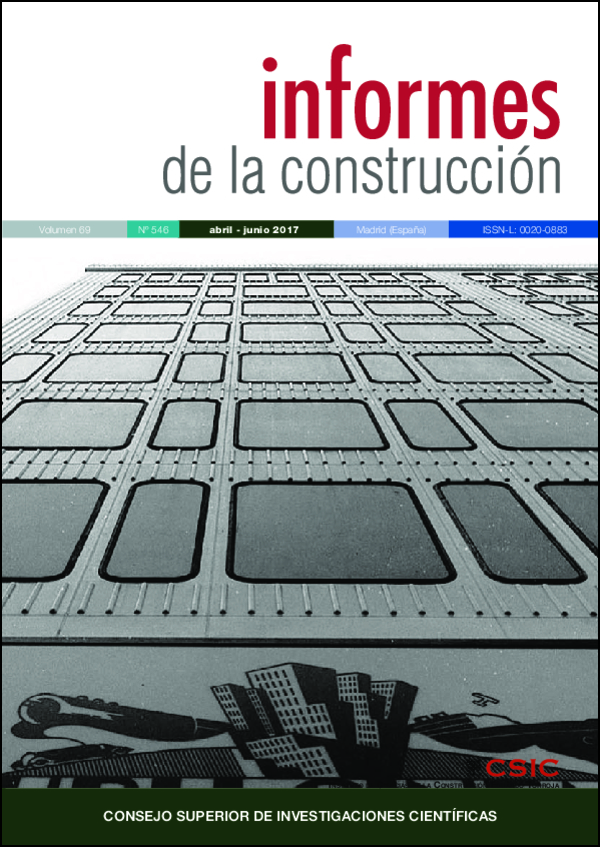Architectonic context and technological implements for Teodoro Ansagasti’s Monumental Cinema
DOI:
https://doi.org/10.3989/ic.16.006Keywords:
architecture, cinema, building services, construction, integrationAbstract
Overcoming the economical crisis that Spain suffered in the twentieth century allowed to build more edifices and made possible to follow the concepts of modern European movement. Cinemas were one of the best examples of this attempt of modernity. There are few examples of real quality architecture, and majority of them were built in Madrid or Barcelona. In this context, one of that years’ greatest works has to be put in value: Teodoro Anasagasti’s Monumental Cinema, providing additional architectonic and technological data to the existing historiography.
Downloads
References
(1) Fernández Shaw, C. (1949). Un recuerdo a Teodoro Anasagasti. Cortijos y Rascacielos (53).
(2) Moya, L. (1957). Teodoro Anasagasti. Revista Nacional de Arquitectura (191): 13.
(3) Apraiz, E. (1960). Un arquitecto vasco olvidado. Teodoro Anasagasti y Albán. Nueva Forma (90-91).
(4) Fullaondo, J. D. (1971). Anasagasti, poesía olvidada. Arquitectura, enero.
(5) García Morales, M. V. (1979). Teodoro Anasagasti, 1880-1938 (Tesina de licenciatura).
(6) Sainz de los Terreros, L. (1909). La pensión de arquitectura en Roma. La Construcción Moderna (6): 108-110.
(7) Flores, C. (1983). Teodoro de Anasagasti: Enseñanza de la arquitectura. Arquitectura (64): 36.
(8) Bode, Paul, et al. (1957). Kinos: Filmtheater und Filmvorführr.ume, München: Callwey. PMCid:PMC90444
(9) Cladel, G., Feigelson, K., Gevaudan, J.-M. (2001). Le cinéma dans la cité, Paris: Kiron/Félin.
(10) Hänsel, S., Schmitt, A. (1995). Kinoarchitektur in Berlin 1895-1995, Berlin: Reimer.
(11) Lacloche, F. (1981). Architectures de cinemas. Collection Architecture «Les Bâtiments», Paris: Éditions du Moniteur.
(12) Melnick, R., Fuchs, A. (2004). Cinema Treasures, A New Look at Classic Movie Theaters. MIB Publishing Company.
(13) Naylor, D. (1981). American Picture Palaces. The Architecture of Fantasy, New York: Prencite Hall Press.
(14) Schliepmann, H. (1914). Lichtspieltheater: eine Sammlung ausgeführter Kinohauser in gross-Berlin, Berlin: Ernst Wasmuth A.G.
(15) Stindt, O., Zucker, P. (1931). Lichtspielhauser Tonfilmtheater, Berlín: E. Wasmuth.
(16) Vergnes, E. (1925). Cinémas. Vues extérieures et intérieures, details, plans, Paris: Librairie Générale de l’Architecture et des Arts Décoratifs.
(17) Wilms, F. (1928). Lichtspieltheaterhauben, Berlín: E. Wasmuth.
(18) Zucker, P. (1926). Theater und Lichtspielhauser, Berlín: E. Wasmuth.
(19) Cebollada, P., Santa Eulalia, M. G. (2002). Madrid y el cine. Panorama filmográfico de cien años de historia, Madrid: Consejería de Educación de la Comunidad de Madrid.
(20) De la Madrid, J. C. (coord.) (1996). Primeros tiempos del cinematógrafo en España, Oviedo: TREA.
(21) Gutiérrez Cabrero, L. A. (1986). Arquitectura moderna y cine: su estructura comparada como principio objetivo para la comprensión y creación arquitectónica (Tesis doctoral). Madrid.
(22) Anasagasti, T. (1919). El cine moderno. La Construcción Moderna (3): 25. Madrid.
(23) Anasagasti, T. (1911). IX Congreso Internacional de Arquitectos en Roma; resumen de las sesiones. Arquitectura y Construcción (232): 322. Madrid.
(24) VV. AA. (2004). Anasagasti. Obra Completa. Exposición organizada por el Ministerio de Fomento, 2 de diciembre de 2003-26 de enero de 2004. Madrid: Ministerio de Fomento.
(25) Recknagel-Sprenger, W. (1972). Manual de calefacción y climatización (incluido preparación de agua de consumo y técnica del frío), pp. 769-771, Editorial Blume.
(26) Banham, R. (1975). La arquitectura del entorno bien climatizado, Infinito. PMid:1141528 PMCid:PMC1675159
(27) VV. AA. (2000). Mutaciones, p. 130, ACTAR.
(28) Nagengast, B. (1999). Early Twentieth Century Air-Conditioning Engineering. ASHRAE Journal, March, p. 61.
(29) Bodinus, W. S. (1999). The Rise and Fall of Carbon Dioxide Systems. ASHRAE Journal, April, p. 39.
(30) Urrutia, A. (1997). Arquitectura española siglo XX, pp. 218-219, Ediciones Cátedra, S. A.
(31) Anasagasti, T. (1923). Características del cine. La Construcción Moderna (21): 334-340, noviembre.
(32) Anasagasti, T. (1923). El edificio. La Construcción Moderna (21): 341-355, noviembre.
(33) Monumental Cinema. Un nuevo salón cinematográfico. ABC, 20 de octubre de 1923, p. 6.
(34) Betancor Pérez, F. (2000). Las Palmas de Gran Canaria y sus cines olvidados: aproximación a la historia de la arquitectura cinematográfica a través de los proyectos que quedaron en papel. En Coloquio de Historia Canario-Americana, XIII, p. 3038, Las Palmas: Ediciones Cabildo de Gran Canaria.
(35) Gómez de la Serna, R. (1923). La obra de arte de Anasagasti. La Construcción Moderna (21): 356, noviembre.
(36) Alcántara, F. (1923). Anasagasti, constructor. La Construcción Moderna (21): 356, noviembre.
(37) Francés, J. (1923). La estética del cine. La Construcción Moderna (21): 356, noviembre.
(38) Donosty, J. M. (1924). Anasagasti y su gran cinematógrafo. La Construcción Moderna (1): 10-12, enero.
(39) Gubern, R., et al. (1995). Historia del cine español, p. 88, Madrid: Ediciones Cátedra, S. A.
Published
How to Cite
Issue
Section
License
Copyright (c) 2017 Consejo Superior de Investigaciones Científicas (CSIC)

This work is licensed under a Creative Commons Attribution 4.0 International License.
© CSIC. Manuscripts published in both the print and online versions of this journal are the property of the Consejo Superior de Investigaciones Científicas, and quoting this source is a requirement for any partial or full reproduction.
All contents of this electronic edition, except where otherwise noted, are distributed under a Creative Commons Attribution 4.0 International (CC BY 4.0) licence. You may read the basic information and the legal text of the licence. The indication of the CC BY 4.0 licence must be expressly stated in this way when necessary.
Self-archiving in repositories, personal webpages or similar, of any version other than the final version of the work produced by the publisher, is not allowed.















